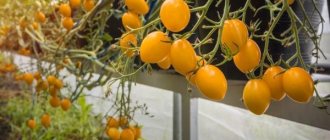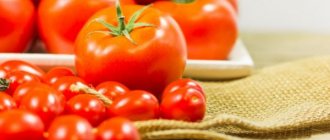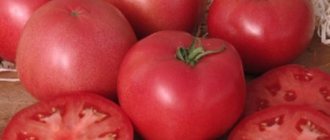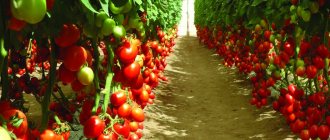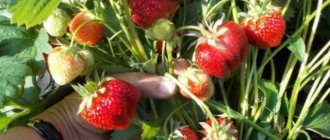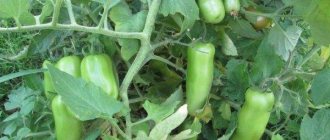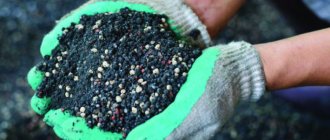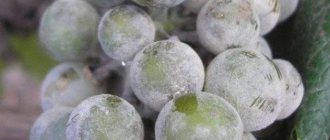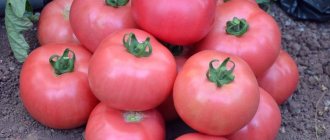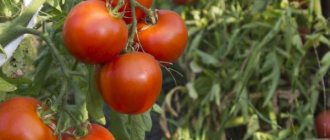Tomato Marfushechka darling - description and characteristics of the variety
Plant:
- The bush rarely grows to a height of more than 1 m, most often it grows no more than 70 cm, but the autochorus is strong and strong.
- The leaves are the most common, characteristic of most types of tomatoes, the shoots are even and straight, the number of leaves on the bush is average.
- Dushechka is a hybrid variety specially bred for cultivation in open ground. The bushes can withstand without any problems (barely spring frost in the mornings and the vagaries of the weather - dampness, lack of sunlight, temperature changes).
- The tribe is mid-early - the first harvest is harvested 120-130 days after the first shoots hatch. The tomatoes on the bush ripen together, together. The bush needs to be tied up in time, monitor the appearance of stepsons, and remove them in a timely manner.
Fruit:
- The ripe fruit of Marfushechka Dushechka is round, the shell is very smooth, and has a juicy red color.
- A tomato that has just begun to ripen is yellow; as it ripens, it gradually turns red.
- The inflorescences form a handbrake. Up to 7 fruits can ripen in one cluster.
- A ripe tomato weighs on average 100-120 g.
- The bitterness is pleasant, slightly sweet.
As for yield, the Marfushechka Dushechka variety can produce up to 11 kg of fruit per square meter. In the photo-faces that gardeners and amateur gardeners post online, you can see that the Dushechka variety is quite prolific - the bushes are literally strewn with ripening tomatoes.
Ripe eggs of this variety are tasty and aromatic. They are consumed raw, in salads, pickled, cooked in tomatoes, soups, juice, and used for pickles and preservation.
An early-ripening, determinate, low-growing tomato variety for open ground.
The height of the bush is up to 60 cm, the bush is spreading and powerful. This tomato does not require pinching, but it does need a garter.
The fruits are round, smooth, dense, tasty, red in color at maturity, weighing up to 150 grams. These tomatoes are suitable for both fresh consumption and canning.
Planting pattern 70 x 30 - 40 cm. Planting density: 6-8 plants per 1 sq.m.
Reviews from those who planted Dushechka tomatoes are unanimous in that it sets fruit well even in cool summers.
TamaraTomat lives up to its name. The soul rejoices to look at the harvest and pick tomatoes.
This is a high-yielding, mid-early, low-growing variety of tomatoes for open ground. Bush up to 70 cm tall, completely covered (even the leaves are not visible) with round shiny red fruits
. The fruits ripen all together, withstand transportation well, and are tasty fresh, pickled or canned. The variety is resistant to adverse weather conditions.
Advantages and disadvantages of the variety
The advantages of the variety include:
- Good yield.
- Flattering presentation of ripe tomatoes.
- Good resistance to the most common tomato diseases.
- Mobility. Ant. static bad climatic conditions and spring frosts.
- The fruits tolerate long-term transportation well.
As for any serious deficiencies of the variety, they are excluded. It is only worth mentioning the need to pin the bushes and tie them to pegs. So these are, rather, the peculiarities of caring for bushes, and there is a lack of variety.
Compared to other tomato varieties, Dushechka probably wins due to its unpretentiousness, productivity in poor climatic conditions and high commercial and taste qualities.
Some nuances of growing and caring for the variety
Seedlings of the Marfushechka Dushechka variety can be successfully grown at home in a box on the windowsill. Seeds should be planted in a box with specially prepared soil heated to 15 C about 2 months before the intended planting of seedlings in open ground. On the eve of planting, the soil in the garden bed needs to be loosened well and vitamins added (soils responsible for the yield and growth of bushes.
On one square m. beds need to be no more than 2-3 Dushechka bushes. There are no special conditions for growing and caring for this variety. Regular watering, especially in dry, hot weather, timely covering, loosening the soil near the bushes, destroying weeds, timely fertilizing - you see, perhaps, everything that is necessary to obtain a good harvest.
In general, the conclusion of most gardeners and gardeners about this variety is positive. The tomato, to be honest, justifies its popularity.
Sometimes gardeners note that the height of the bush is sometimes less than in the description of the variety.
If we talk about resistance to temperature changes, there is no doubt: the tomato is really very unpretentious and is able to withstand both heat and spring frosts.
Reviews from gardeners
- Tamara Sivaeva, 28 planning: I grew a tomato in the garden. The variety fully lives up to its name. The soul truly rejoices when you reap the harvest. That's all - and that's to say, Darling is very unpretentious to temperature. Our climate in Udmurtia is not incredibly suitable for tomatoes, but I was pleased with this variety.
- Ninosha Alekseeva, 40 years old: A good, productive variety, the fruits ripen perfectly, about the same size. I do not recognize either yellow or green varieties. I think pink and red butts are the most delicious. I tried growing Darling in a greenhouse and in a garden bed. In open ground, the article, oddly enough, bears fruit better.
- Ksenia Frolova, 35 flight: Marfusha is one of the first places for me. It is perfect for our temperate and damp climate. I advise all lovers of delicious tomatoes to also try Thick-red Onslaught and Giant of the Moscow Region.
"Morozko": life after the premiere
The premiere screening of the film was a resounding success. The fairy tale “Morozko” triumphantly marched across all blue screens. The actors woke up famous the next morning. But despite the successful start, the acting career did not work out for either Sedykh or Izotov.
Due to the vicissitudes of fate, Izotov was arrested and sent to prison for three years with confiscation of property. In Soviet times, it was not customary to discuss such sensitive issues, and the viewer did not know that the hero of their favorite fairy tales suffered six strokes and died in a mental hospital.
Natalya Sedykh voluntarily decided to leave cinema and devote herself fully to ballet. After her ballet career ended, the actress-ballerina tried to return to cinema, but all her roles turned out to be passable and did not bring the actress either her former glory or critical praise.
Yaga with experience and Marfushenka
“Morozko” is a film whose actors, as one, fell under the charm of the actor playing the role of Baba Yaga, Georgy Millyar. The actor turned out the evil old woman perfectly, evolving from fairy tale to fairy tale. But he had a problem: he drank alcohol almost every day. Rowe was terribly angry with him because of this, but he couldn’t do anything about his pet. One day Miller literally saved the painting from destruction. He was the only one in the room where the footage was lying at the moment when the pipe burst there. The actor immediately jumped into the icy water and brought out the films.
Two actresses applied for the role of Marfushenka-darling, or rather, one full-fledged one - the experienced prima Tamara Nosova and the second - student Inna Churikova, for whom filming in films was supposed to be her debut. Unspoiled Churikova, without a shadow of a doubt, fulfilled all the requirements of the demanding director - she climbed without hesitation into a dirty pond infested with leeches, gnawed nuts without sparing her teeth, so Rowe chose her. Many of the participants in the filming process did not understand the director's choice, especially the more experienced actors.
Curious facts about the behind the scenes of the fairy tale film “Morozko”
The film adaptation of the Russian folk tale “Morozko” has been delighting young viewers for decades. The fairy tale story of how good defeats evil has always been and remains relevant. And interesting facts about the fairy tale film will encourage you to watch it more than once.
Nastenka is 15-year-old Natalya Sedykh.
onedio.com
The girl studied figure skating and ballet, performing the “Dying Swan” dance at children’s parties, which helped her get a role in “Morozko.” The fact is that director Alexander Rowe saw one of these performances and immediately decided that this girl should play the main role in his film.
The Arts Council insisted that the role of Nastenka be played by Nadezhda Rumyantseva, already a well-known performer of the leading roles in the cult “Girls” and “Queen of the Gas Station,” but the director was adamant.
onedio.com
Natalya Sedykh was too young for such a role, and besides, she had no experience and had a too high-pitched voice. Each time, the girl with the scandal had to be asked to leave the choreographic school for filming, and also with the help of makeup to make her a little older.
Nastenka achieved the effect of frozen eyelashes using ordinary glue.
onedio.com
According to the 15-year-old actress, the most difficult thing was not even to endure the cold (the film was filmed in a real environment, on the cold Kola Peninsula), but to remove the makeup from the eyelashes after the shooting day.
Another difficulty was the unrequited love of on-screen Ivan (actor Eduard Izotov).
onedio.com
Inna Churikova wanted to become Marfushenka-darling so much that during the auditions, not sparing her teeth, she chewed through a whole mountain of nuts.
onedio.com
And the girl was finally hired for the role. But seeing herself on the screen, Churikova was terribly upset: “How scary I am... Who will marry me!” The actress even doubted that she had chosen the right profession.
Instead of apples, Marfushenka-darling ate fresh onions, washing it down with milk...
onedio.com
Remember this scene when Marfushenka-darling was waiting for Morozko? Here she was supposed to eat fresh apples, but bad luck: the actress forgot the apples at the hotel, so she ate onions (they gave a similar crunch).
The performer of the role of Baba Yaga, Georgy Frantsevich Millyar, was often tipsy on camera.
onedio.com
The actor loved his image very much (this was not the first time he played an evil witch in fairy tales), so each time he himself added some new features to his Baba Yaga (both in costume and in manners). But the actor loved to drink, which the director really disliked, who always ordered him not to sell alcohol to the actor. But the saleswoman from the local store could not follow these instructions: she loved the actor too much. The woman put the bottle in a can and poured milk on top.
Georgy Millyar saved the film.
onedio.com
The fact is that all the film with the filmed parts of the film was packed into bags and placed in the basement of the house in which the film group lived. One day there was a flood in the house: a pipe burst. The director was terrified, because the entire film could be ruined, and then the entire film would simply have to be re-shot. When the group arrived at the house, everyone saw a wet and numb Millyar, who was barefoot dragging films out of the basement into the snow. As you can already guess, the film was saved.
On one of the American TV shows, the film was perceived not as a fairy tale, but as an old thriller or horror film.
onedio.com
But nevertheless, at the Venice Film Festival the film received the main prize in the program of children's and youth films, as well as the prize for best children's film at the All-Union Film Festival. The fairy tale is very popular in the Czech Republic and Slovakia: in these countries it is considered the same traditional New Year’s film as, for example, in our country “The Irony of Fate...”.
Based on materials from: onedio.ru
Description of the Dushechka-Marfushechka tomato and characteristics of the variety, growing rules
The hybrid tomato Dushechka-Marfushechka was created by plant breeders for planting in open ground and temporary greenhouses. The variety is registered in the State Register in the section of early ripening varieties.
Description of the variety Dushechka
At a summer cottage, the Marfushechka-darling tomato will become a real decoration, as it is characterized by excellent productivity, unpretentiousness, and resistance to diseases, infections and viruses. Characteristics of Darling F1 is characterized by a balanced composition of minerals, sugar and organic acids. Thanks to many years of testing, scientists managed to ensure that the variety perfectly tolerates drought, cold snaps, and weather changes, which is often observed during the period of flowering and ripening of fruits.
Let's look at the description of the variety. The Marfushechka-darling tomato, according to reviews from summer residents, is very profitable to grow in their gardens. Among the main characteristics that distinguish the variety from other early ripening fruits, it is worth noting the following:
- The height of each bush of the variety reaches 60-75 cm.
- The plant has an average number of leaves, which are practically invisible due to the many fruits.
- The bushes are strong and powerful with well-developed tassels.
- The fruits have a round shape, weak ribbing, and a loose structure.
- The weight of each tomato is 150-180 g.
- The variety has smooth and dense tomatoes, with medium-density pulp. No green spots were found on the stalk.
- Dushechka F1 tomatoes have a sugary taste.
- The fruits do not crack, even very ripe ones.
- Tomatoes are light green at the beginning of ripening, and when the fruit becomes ripe, it turns bright red or just red.
- Each cluster has 4-6 fruits.
From each bush you can collect several kilograms of tomatoes (up to 8 kg per 1 m²). To ensure high yields, experts recommend planting bushes not too close to each other, no more than 4 bushes per 1 m².
The average ripening period is about 3 months or a little more.
In the description of tomatoes of this variety, it is important to note that the plant, when ripe, is covered with large green leaves, has a simple inflorescence and a stalk with an articulation. Tomatoes are used for preparing fresh and canned salads, tomato purees, soups, tomato juice, canning
Tomatoes are used for preparing fresh and canned salads, tomato purees, soups, tomato juice, and canning.
Benefits of tomato
Advantages of the tomato Dushechka F1:
- resistance to Alternaria blight, bacterial black spot, tobacco mosaic virus;
- heat resistance;
- early ripeness;
- large fruit;
- high quality fruits;
- suitable for long-term transportation;
- requires moderate pinching.
High-yielding mid-early low-growing variety for open ground. The bush is up to 70 cm high, forms several clusters, abundantly loaded with round, shiny red fruits. Tomatoes weighing up to 150 g, ripen massively, are tasty fresh, salted and canned.
Let's look at the benefits of tomatoes and the features of cultivation.
The Marfushechka-darling tomato has the following advantages:
- Resistance to cold weather, which is why the variety is grown in the harsh climate of Siberia.
- The fruits have excellent commercial qualities.
- Darling has average resistance to diseases that can affect plants.
The variety has practically no disadvantages. You just need to carry out pinching and tie the stems to the trellises so that the bushes do not break during growth.
How to grow tomatoes?
Among the nuances of growing tomatoes of the Dushechka-Marfushechka variety, as can be seen in the photo, the following can be noted:
- Sowing seeds in the ground for seedlings is carried out in such a way that after 60 days, that is, after 2 months, the seedlings are planted in a greenhouse or in open ground.
- Before sowing, the soil must be treated with fertilizers responsible for growth and productivity.
- Planting must be done in special containers.
- Seeds should germinate in a warm room, where a stable temperature of +23...+25 ºС should be set.
- It is necessary to regularly water the plant, feeding the bushes with mineral fertilizers.
- Summer residents should grow tomatoes in 2 stems, tying them up and pinching them to the first bunch.
If you properly care for the plants, watering the bushes, removing weeds, feeding, then you can get not 8 kg, but 9-10 kg of harvest from 1 m².
https://youtube.com/watch?v=Z97bv–JQtE
Advantages and disadvantages of the variety
Reviews of the Cherry Strawberry F1 tomato from those farmers who planted the hybrid, as mentioned earlier, are mostly positive. Despite the fact that the hybrid has many advantages, it has a number of disadvantages.
Advantages:
- Gives a good harvest throughout the season;
- Very tasty fruits;
- The hybrid is not demanding in care;
- Good decorative qualities;
- Immunity to diseases of nightshade crops;
- Harmonious ripening of tomatoes.
Flaws:
- The variety is not high-yielding;
- The fruits do not differ in shelf life;
- Not suitable for preparing tomato juices and pastes;
- Bushes need to be tied up;
- It is necessary to form bushes;
- Seedlings can only be grown in open ground in the southern regions of Russia. In northern latitudes, it is recommended to use greenhouses and greenhouse shelters.
Characteristics and description of the tomato variety Marfushechka Dushechka
p http-equiv=”Content-Type” content=”text/html;″>an itemprop=”image” itemscope itemtype=”https://schema.org/ImageObject”>
An early-ripening, determinate, low-growing tomato variety for open ground.
The height of the bush is up to 60 cm, the bush is spreading and powerful. This tomato does not require pinching, but it does need a garter.
We recommend sowing seeds for seedlings 55-60 days before the intended planting in the ground.
Planting pattern 70 x 30 - 40 cm. Planting density: 6-8 plants per 1 sq.m.
Reviews from those who planted Dushechka tomatoes are unanimous in that it sets fruit well even in cool summers.
Tamara Tomat lives up to its name. The soul rejoices to look at the harvest and pick tomatoes.
Tomato Dushechka is a determinate, low-growing hybrid.
Low shoots grow up to 50 cm and do not need pinching. The bushes are spreading, the foliage is moderate. The brushes are complex, each with 8-10 tomatoes.
Description of fruits:
- weight 100-150 g;
- ribbing is noticeable at the stalk;
- color bright red;
- the pulp is juicy, there are 4-6 seed chambers;
- the taste harmoniously combines sourness and sweetness.
The ripening period is mid-early - 95-100 days from germination.
Variety Marfushechka-darling
This is a high-yielding, mid-early, low-growing variety of tomatoes for open ground. Bush up to 70 cm tall, completely covered (even the leaves are not visible) with round shiny red fruits
. The fruits ripen all together, withstand transportation well, and are tasty fresh, pickled or canned. The variety is resistant to adverse weather conditions.
Plant:
- The bush rarely grows to a height of more than 1 m, most often it grows no more than 70 cm, but the autochorus is strong and strong.
- The leaves are the most common, characteristic of most types of tomatoes, the shoots are even and straight, the number of leaves on the bush is average.
- Dushechka is a hybrid variety specially bred for cultivation in open ground. The bushes can withstand without any problems (barely spring frost in the mornings and the vagaries of the weather - dampness, lack of sunlight, temperature changes).
- The tribe is mid-early - the first harvest is harvested 120-130 days after the first shoots hatch. The tomatoes on the bush ripen together, together. The bush needs to be tied up in time, monitor the appearance of stepsons, and remove them in a timely manner.
Fruit:
- The ripe fruit of Marfushechka Dushechka is round, the shell is very smooth, and has a juicy red color.
- A tomato that has just begun to ripen is yellow; as it ripens, it gradually turns red.
- The inflorescences form a handbrake. Up to 7 fruits can ripen in one cluster.
- A ripe tomato weighs on average 100-120 g.
- The bitterness is pleasant, slightly sweet.
As for yield, the Marfushechka Dushechka variety can produce up to 11 kg of fruit per square meter. In the photo-faces that gardeners and amateur gardeners post online, you can see that the Dushechka variety is quite prolific - the bushes are literally strewn with ripening tomatoes.
Ripe eggs of this variety are tasty and aromatic. They are consumed raw, in salads, pickled, cooked in tomatoes, soups, juice, and used for pickles and preservation.
Features of cultivation and storage
Seeds are sown in the first half of March.
How to grow seedlings:
- temperature regime 20-22 degrees;
- feeding 2 times;
- picking.
They are transplanted into beds when there are 7-8 true leaves.
Moments of care:
- heavy wrist garter;
- watering 2-3 times a week;
- fertilizer with liquid organic matter and phosphorus-potassium agents.
Ultra-early / Low-growing
Seedlings of the Marfushechka Dushechka variety can be successfully grown at home in a box on the windowsill.
Seeds should be planted in a box with specially prepared soil heated to 15 C about 2 months before the intended planting of seedlings in open ground.
On the eve of planting, the soil in the garden bed needs to be loosened well and vitamins added (soils responsible for the yield and growth of bushes.
On one square m. beds need to be no more than 2-3 Dushechka bushes. There are no special conditions for growing and caring for this variety. Regular watering, especially in dry, hot weather, timely covering, loosening the soil near the bushes, destroying weeds, timely fertilizing - you see, perhaps, everything that is necessary to obtain a good harvest.
If we talk about resistance to temperature changes, there is no doubt: the tomato is really very unpretentious and is able to withstand both heat and spring frosts.
How to grow cherry strawberry correctly
The process of growing seedlings is the most important stage in gardening. To get a rich harvest, you need to pay special attention to it. The process of growing cherry tomatoes is practically no different from planting regular tomatoes.
We invite you to familiarize yourself with the Evergreen precious Ludisia orchid: description of the variety and care at home
First of all, it is important to know exactly the timing of sowing seeds. For Cherry Strawberry tomatoes, this is the beginning of April. Seedlings should be planted in open ground when the temperature remains above zero at night. The soil should warm up to 16 - 18 degrees.
I planted seeds for seedlings in this way:
- Pour soil into containers (you can buy a ready-made mixture in the store);
- Make furrows to a depth of 2 - 3 cm and plant planting material, water;
- Cover the boxes with cling film and take them to a warm place;
- Regularly remove the film and water the seeds;
- After the shoots appear, the film is removed and the boxes are placed in the sun.
When full-fledged leaves appear on the seedlings, it must be pruned. Cherry tomatoes do not like crowding and may not grow well. If the spring turns out to be cold and the bushes “sit” in the container for a long time when picking, the stem can be buried.
Farmers who have planted tomatoes of this variety know that its distinctive feature is the need to form bushes into one or two stems.
